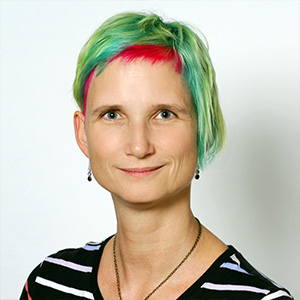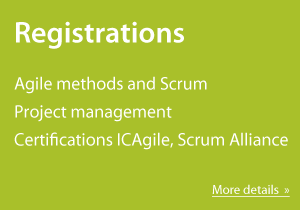

ICP-ACC - ICAgile Certified Professional in Agile Coaching - training in Prague on 17-18 September 2025
Date: 17-18 September 2025
Duration: 2 days
Early bird price: 24 000 CZK plus VAT (21%) valid until 30 days before the start of the training
Regular price: 29 000 CZK plus VAT (21%) otherwise
Place: Prague, Czech Republic
Language: English
Training is delivered by John Barratt accredited ICAgile trainer.
read moreDAO - Certified – Designing Agile Organizations - training in Prague on 17-18 September 2025
Date: 17-18 September 2025
Duration: 2 days
Early bird price: 1 095 EUR plus VAT (21%) valid until 30 days before the start of the training
Regular price: 1 295 EUR plus VAT (21%) otherwise
Place: Prague, Czech Republic
Language: English
Training is delivered by Jurgen De Smet accredited LeSS (Large Scale Scrum) trainer.
read moreJoin our Advanced ScrumMaster and Advanced Product Owner training in April 2025
Join me on confirmed A-CSM Advanced Certified ScrumMaster and A-CSPO Advanced Certified Scrum Product Owner training on April 22-23, 2025 and April 24-25, 2025 respectively in English.
Training will be delivere online (Zoom)
Register here. Looking forward.
read moreBefore the class
To get most from the upcoming class...
... we recommend that you invest some time in the self-preparation activities described below:
1. Core knowledge
Certification classes from the Scrum Alliance are advanced classes that expect some basic level of understanding and terminology. Review links in the core section so you can have a conversation with other participants about those concepts.
CRITICAL FOR ALL WHO HAS NO EXPERIENCE WITH AGILE and SCRUM
Check here: Core section
2. Read through the class-specific section
Certified ScrumMaster (CSM) OR Certified Product Owner (CSPO) OR Certified Agile Leadership (CAL1) links
3. Review FAQ
Frequently asked questions (FAQ) reply to the most common question people ask.
4. Extras
For more information check the additional reading list.
Core knowledge
Understand the Scrum framework and terminology
- read the Scrum Guide - CRITICAL FOR ALL WHO HAS NO EXPERIENCE WITH SCRUM
- running out of time? Watch this 10 min video
- running out of time even more? Read A Simple guide to Scrum (you can open it in different languages, Czech translation)
Agile Fundamentals (CSM, CSPO, CAL) you should be familiar with the basics and terminology:
- review the Agile Manifesto and think about examples from your organization. Do you value the items on the left more?
- read through Frequently Asked Questions (FAQ) at the bottom of this page to get some of the most common questions answered.
Certified ScrumMaster (CSM) pre-course reading
Read at least one case-study and be ready to discuss it with other participants: https://less.works/case-studies/index.html
Certified Product Owner (CSPO) pre-course reading
- Think about your product vision. What makes it a great product?
Certified Agile Leadership (CAL1) pre-course reading
Go through the following case studies and choose at least two from additional case-studies below:
- https://www.infoq.com/presentations/dbs-bank-startup
- http://www.valvesoftware.com/company/Valve_Handbook_LowRes.pdf
- https://www.gsb.stanford.edu/faculty-research/case-studies/zappos-happiness-box
- https://www.ted.com/talks/david_logan_on_tribal_leadership
Additional case-studies
- Company Without Structure - Odde: http://yihuo.de/articles/150
- Crisp DNA: https://www.cs.usfca.edu/~parrt/course/601/lectures/Lean-from-the-trenches.pdf
- Henrik Kniberg - Spotify Engineering Culture part 1
- Henrik Kniberg - Spotify Engineering Culture part 2
- http://www.forbes.com/sites/stevedenning/2015/10/27/surprise-microsoft-is-agile/#4ec9dbc44b9e
- http://www.forbes.com/sites/stevedenning/2015/10/29/microsofts-sixteen-keys-to-becoming-agile-at-scale/#72bb4aae8f4d
- http://www.forbes.com/sites/stevedenning/2015/07/22/how-to-make-the-whole-organization-agile/#34ac1f4b135b
- http://less.works/case-studies/agfa-healthcare.html
Additional reading materials
- Book: Zuzana Sochova - The Great ScrumMaster: #ScrumMasterWay
- “Scrum and XP from the trenches” http://www.infoq.com/minibooks/scrum-xp-from-the-trenches/
- “Scrum and Kanban: making most of the both” http://www.infoq.com/minibooks/kanban-scrum-minibook/
- “Lean from the trenches” https://www.crisp.se/file-uploads/Lean-from-the-trenches.pdf
- Zuzi’s Blog about Agile and Scrum: http://agile-scrum.com/ or my Czech blog at http://soch.cz/blog
FAQ - Frequently asked questions
Can ScrumMaster be a team member at the same time?
They can, but they will never become great ScrumMasters as they would lose their ability to see things from the distance, become too involved and stop pushing the team into the un-comfort zone. They lose focus and never create a great self-organized team. If you feel you need to do more, take another team or preferable move to the next level of the #ScrumMasterWay concept.
What are the typical misunderstandings of the Product Owner role?
As Scrum Guide says, "The Product Owner is one person, not a committee". If you want to learn more, watch this video: https://youtu.be/cr2rjaGmUzo.
Can we use Scrum for fixed time, budget & scope projects?
Scrum is an iterative approach that helps us to deliver the highest value first. It is applicable to any environment despite the size, complexity, or contract. If you use Scrum for fixed time, budget & scope project you raise visibility and predictability of the delivery.
Can the Scrum team work on multiple projects?
Scrum is a way how to deliver products by stable teams. If we still have projects in Scrum, they are usually taken as large Product Backlog Items.
Can we use Scrum for maintenance projects?
In general, you have two options. Handle maintenance with a separate team and use Kanban to make it more transparent, or make the team(s) fully cross-functional and let them handle both maintenance and new development as both are delivering value to the product.
Do we still need Project Managers in Scrum?
Scrum only defines three roles – ScrumMaster, Product Owner, and Development team – so there are no Project Managers needed in Scrum. The responsibilities were distributed equally among those three roles, but don’t be afraid, people are still needed in an organization as either ScrumMasters, Product Owners, or stakeholders/internal customers because of their experience. There is no simple match to assign traditional roles to the new ones. It’s up to you to figure it out based on their skills, experiences, and personality.
Which tool shall we use to manage the Backlog?
Keep in mind that we value individuals & interactions over processes & tools. In general, you don’t need any tools. The wall with post-it notes is just good enough. Excel or Google Sheet will do a great service. Both solutions are very flexible, keep in mind that the tool shall support your way of working not vice-versa. See the Backlog Example.
Who shall be part of the cross-functional team?
Anyone who is needed to deliver end-to-end value to the customer. Typically, developers, testers, and analytics.
Why the team has to be stable and 100% allocated?
If they are not, it’s very painful. They never become a team, but a group of individuals. They never got used to each other, they never become high-performing. If you like to allocate people to tasks – use waterfall. Scrum has stable teams that are choosing work from the Product Backlog.
Who assigns people to the Scrum team?
Scrum doesn’t say anything about it. At the beginning of your Agile journey, it’s most likely your manager, sometime later you will run it as a self-organizational workshop and let people decide.
How shall we implement Scrum?
Scrum itself is simple, but the implementation is a complex task. Therefore, there is no cookbook, no checklist, not even any complicated process to follow. You have to Figure it yourself. Inspect & Adapt.
Why KPIs are not that useful?
Organizations often use Key Performance Indicators (KPI’s) and metrics in dysfunctional ways, which result in gaming, reduced performance, undesired behaviors, and focusing on unimportant things. Have a look at 9 ways to fail with KPIs.
Can you share some practical case-studies from Agile transformation?
- Port of Rotterdam transformation: This is a story about four cross-functional feature teams (that also did operations; i.e., DevOps) delivering and managing a business-critical 24/7 harbor management product used by vessel-traffic services operators and several other types of users.
- Large-Scale Scrum (LeSS) @ JP Morgan: This case-study shares the experiences of a large group in a tier-one financial services firm adopting Large-Scale Scrum (LeSS).
- Spotify Engineering Culture part 1, Spotify Engineering Culture part 2: short animated videos describing Spotify engineering culture.
Why should I attend a class and not just read through the materials and books?
Agile and Scrum are not about practices, artefacts, and roles. It’s a different mindset, a different way of working. Therefore, the classes are experiential, interactive, with plenty of exercises and conversations in teams. They are designed in such a way that enables you to deepen your experience and understanding and be successful in your role of a great ScrumMaster/Product Owner/Agile Leader.


